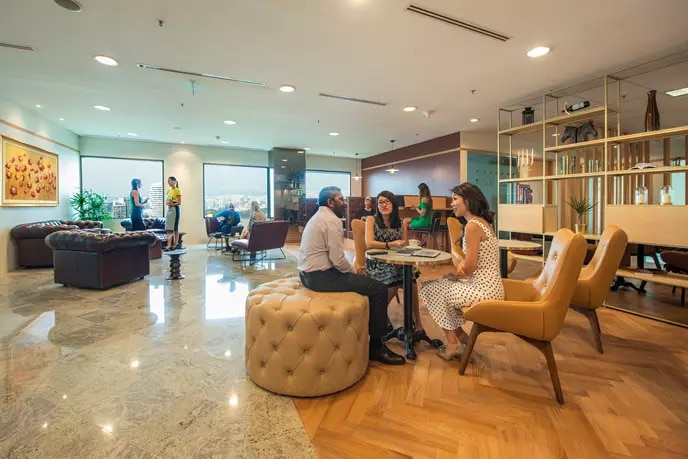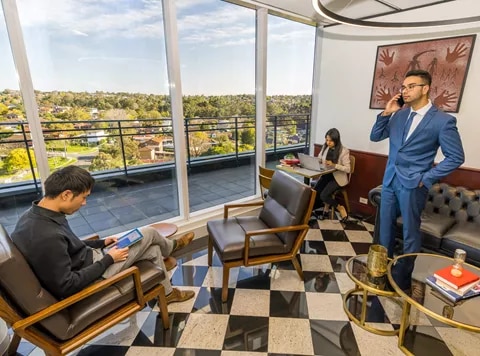Serviced Office vs Coworking Space: A Comprehensive Comparison

Flexible workspaces have become a favourite in the Australian business environment as professionals seek more than the traditional office lease. Serviced offices and coworking spaces are two of the most common solutions employed because of their myriad of services.
But is one better than the other? Often, people compare a serviced office vs coworking space, and while both offer flexibility with convenience, there are distinct differences between the two.
In this comprehensive comparison, we will delve into the key differences, advantages, and disadvantages between serviced offices and coworking spaces so you can select the one that suits your business needs.
What is a serviced office?

A serviced office is a workspace that comes fully furnished and includes access to facilities and support services for a cost-effective solution. They typically include quality furniture, Wi-Fi and shared facilities such as kitchens, boardrooms and phone booths.
Each serviced office provider will include a variety of different services and business enhancing amenities that helps you progress your business goals. Serviced office space providers vary greatly on their packages, so it's crucial to differentiate their offerings and get the best deals on the market.
What are the benefits of Serviced Offices?
From fully furnished private office spaces to high-speed internet connectivity, these offices provide convenience and efficiency for entrepreneurs and professionals alike.
Fully furnished office spaces
Businesses that rent a traditional office have complete freedom over their office design, but this comes at a significant cost. A serviced office comes with all the necessary equipment and modular furniture required to run a business, so a company can start working in a managed office space immediately without the hassle and expense of purchasing their own assets.
Serviced offices tend to provide quality equipment for you to run your business. From storage space and printers to desks and chairs, the concern of spending thousands on furniture is non-existent. Logistics also become simplified, with computers being the only equipment that must be self-supplied.
Keep in mind that not all serviced offices will have the same amenities, with each provider having different standards that fit different business niches.
Saving capital
The cash flow needed for leasing a conventional office is monumentally greater than its flexible counterpart.
Besides a lease, businesses must pay for outgoings, furniture, technology, and maintenance. And depending on how much they depreciate, you'll need to buy even more tech, equipment and furniture to keep up with the competition. This cost is further amplified every time a company decides to expand its footprint. All of these costs are mitigated with a serviced office, with many providers offering the latest tech and necessary equipment needed for you to run your operations as part of the rental package.
Quality meeting rooms
Not every meeting can be held in your office, but conveniently, most serviced offices have fully furnished meeting rooms or boardrooms that can be booked for the day.
For example, Servcorp's meeting rooms are designed to accommodate client meetings, presentations, and collaborative sessions. All spaces are equipped with modern technology for seamless productivity and businesses save plenty of capital by renting these spaces, as opposed to building it themselves.
It's also quite convenient since searching externally for meeting spaces is unnecessary.
Business enhancing technology
A serviced office is more than a desk and a chair encased by four walls with a frosted glass door.
What makes the difference is access to technology.
A quality serviced office has technology that enhances your business operations, with no IT infrastructure commitment needed by the tenant.
Serviced offices will include Wi-Fi and a phone system, but some providers will have additional benefits.
-
Internet connection: access to VPNs, custom firewalls and internet connections is necessary to keep your business data safe. Ensuring a Tier-1 connection for fast internet speeds is also pivotal.
-
Voice infrastructure: advanced VoIP and conferencing capabilities.
-
Proprietary technology: unique technology such as hot-dialing on your handset for immediate IT support or answering and receiving your business landline calls on your smartphone.
Convenient and great locations
Serviced offices are strategically located in prime areas with easy accessibility to transportation options such as buses, trains, or major highways. Location is an essential factor when selecting a serviced office and you should consider the following questions:
-
Will it impress my clients?
-
Is it easily accessible?
-
Is it an inspirational workspace for you and the team?
-
What perception will it deliver?
For example, a serviced office in the heart of Sydney's Martin Place or Barangaroo is more likely to tick all the boxes while also being cost-effective. Such areas are considered business capitals and are surrounded by many high-performing businesses and amenities.
Acquiring a traditional office in these locations typically requires significant capital and lengthy leases, but a serviced office is very flexible. Consider browsing some of the best-serviced office locations in Australia before signing off any contract.
Drawbacks of Serviced Offices: Lack of Control
Convenience and flexibility are abundant with a serviced office, but they come with some drawbacks. Here are some limitations that businesses should consider if opting for this flexible workspace.
Office layout difficulties
The office is our second home, and as with any place where most of our time is spent, we desire control. Workspace design is still available in a serviced office space, but is significantly limited than the conventional office.
Businesses can't alter the paint on the walls, change the flooring or doors, and remove any light installations. They still have the liberty to bring their own artwork, additional furniture and whatever accessories they like.
It's not a major drawback, but it is one to consider.
Minimal branding opportunities
Branding is a significant aspect of establishing a business's identity.
But serviced offices often restrict branding opportunities to ensure the entire floor has a neutral aesthetic. This ensures that any clients visiting your serviced office won't be confused about why other companies are near your space.
However, branding inside your office space is generally accepted so long as it's not outside your door.
Limited amenities compared to traditional office spaces
Larger companies typically require a lengthier list of amenities.
A conventional office might include services such as cafeterias, gyms, and recreational areas for employee satisfaction. Many serviced offices won't have access to such amenities, but it's all about selecting the right location.
Serviced offices in business districts, such as in Sydney's Market Street, are strategically located for drawing in businesses that require many amenities. Parks, restaurants, bars, gyms, waterfront promenades, and public transport are some of the many features the thoughtfully located serviced offices have.
Regardless of these drawbacks, serviced offices still hold great value for many small businesses or startups:
-
They provide an affordable alternative to long-term leases.
-
Serviced offices offer flexibility in terms of lease duration.
-
They allow businesses to focus on core operations rather than managing administrative tasks like maintenance and cleaning.
What is a coworking space?
A coworking space is an environment that is intended to facilitate work for a diverse range of businesses in a shared office space. They are an ideal workspace for businesses that value collaboration and are the fastest-growing flexible workspace solution.
People who read this article also read 9 Tips on How to Choose a Coworking Space
What are the benefits of Coworking Spaces?
Many companies of all sizes are ditching the traditional office and opting for a coworking space because of its advantages. Coworking spaces foster business growth through offering a cost-efficient alternative for small teams to conduct their operations in. No more isolated cubicles and walls blocking your ideas between your colleagues - through shared facilities, hot desks, and flexible booking systems, coworking spaces create a collaborative environment that fosters networking opportunities between employees and other businesses.
Cost-effective alternative
While a serviced office costs significantly less than a conventional office, many coworking spaces tend to take this to the next level. Commitment durations and upfront costs are minimal, while membership options are broad to cater to various business needs.
-
Members can choose from flexible membership plans based on their requirements and budget, ranging from monthly to yearly payments
-
Monthly memberships allow businesses to scale up or down as needed without being tied down by long-term contracts.
-
Shared resources such as utilities, internet connectivity, and office equipment help reduce overhead costs significantly.
Flexible membership options
The average office space lease in a business district can last five to ten years, Whereas coworking spaces offer monthly, half-yearly, and yearly membership options to give businesses control over their workspace choices.
A coworking space also has two working styles on offer. Hot desks are ideal for businesses that prefer a dynamic environment and are happy to occupy any empty desk, while dedicated desks suit businesses or employees that need a permanent space with more customisability.
Freelancers have begun opting for pay-as-you-go memberships, that can cost as low as $60 per month.
Networking and Collaboration Opportunities
The nature of a flexible office space opens the door for connecting with like-minded individuals during events or even in the kitchen. Often, community managers hold self-promotion opportunities, and other businesses use this as a chance to promote their products or services, promoting a collaborative and flexible environment.
From this, businesses can sell their offerings, find new clients, or make important connections that can lead to potential growth. Ensure that your coworking space provider has community events and ask for an introduction to neighbouring coworkers when joining.
Disadvantages of Coworking Spaces
Noisy Coworkers and music
Loud phone conversations or speaking at a high volume, in general, can quickly become an issue in a coworking space. Unlike a serviced office, there's no door you can close for privacy.
Some coworking floors have music playing in the background - unfortunately, there's normally nothing that can be done about this other than finding a different coworking space.
Some potential solutions include:
-
Finding a coworking space with private phone booths.
-
Speaking with your community manager.
-
Utilizing designated quiet areas.
-
Selecting a coworking space that is quiet and professional.
Lack of Privacy
Another drawback of coworking spaces is the lack of privacy they offer. Shared workspaces often entail open floor plans or shared desks, so you will have plenty of neighbours nearby.
Although most will respect your personal space, it's easy for someone to look over your shoulder to observe your screen or listen in on a conversation. People often question whether coworking spaces are safe, but it all depends on the provider.
Which one should I get?
There's no one-size-fits-all answer, but there are guidelines you can follow.
Small businesses looking to access amenities and workspaces can opt for coworking because of its low cost and flexibility. Whereas larger companies wanting to branch out, reduce overheads, or provide hybrid work conditions can also utilise coworking spaces.
Overall, serviced offices are the closest form of commercial real estate to the traditional office and hold the benefit of being a potential head office or hub-and-spoke office model.
Frequently Asked Questions (FAQ)
1. What is the primary difference between a serviced office and a coworking space?
A serviced office offers fully private office spaces with dedicated facilities, administrative support, and professional services. Coworking spaces provide shared, open workspaces ideal for collaboration, networking, and flexibility.
2. Which option is better for startups: serviced offices or coworking spaces?
Coworking spaces are generally better suited for startups due to their cost-effectiveness, flexible membership plans, networking opportunities, and collaborative environment. However, serviced offices may suit startups seeking more privacy and dedicated resources.
3. How flexible are lease terms for coworking spaces compared to serviced offices?
Coworking spaces usually offer greater flexibility, with membership plans ranging from daily to monthly or longer. Serviced offices typically require longer-term commitments, though many providers now offer flexible short-term arrangements.
4. What amenities typically come with serviced offices and coworking spaces?
Serviced offices generally include reception services, administrative support, furnished private offices, IT infrastructure, and meeting rooms. Coworking spaces usually feature high-speed internet, communal kitchens, networking events, hot-desking, and casual breakout areas.
5. Which option offers better networking opportunities?
Coworking spaces typically offer superior networking opportunities due to their collaborative nature, regular events, and community-driven culture. Serviced offices, while offering fewer networking events, still provide opportunities to connect through shared communal spaces.
Contact Us
If you’ve got any questions call us 1300 409 755 or fill in your information below and we’ll get back to you shortly.





